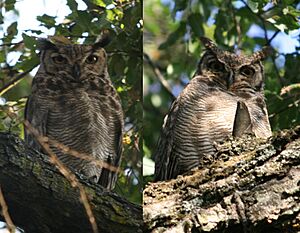Lesser horned owl facts for kids
Quick facts for kids Lesser horned owl |
|
|---|---|
 |
|
| Male (left) and female (right) | |
| Conservation status | |
| Scientific classification | |
| Genus: |
Bubo
|
| Species: |
magellanicus
|
The lesser horned owl is also known as the Magellanic horned owl. Its scientific name is Bubo magellanicus. This large owl lives in southern South America. You can find it as far north as the central Andes mountains.
For a long time, people thought this owl was just a type of great horned owl. But now, scientists know it is its own separate species. They found this out by studying its calls, size, and DNA.
Contents
About the Lesser Horned Owl
What Does It Look Like?
The lesser horned owl is about 45 centimeters (18 inches) long. Owls living in the northern parts of its home range are usually the biggest. This owl has wide wings and a large head. It also has two "ear" tufts on top of its head. These tufts are not real ears, but feathers that stick up.
Its feathers are mostly grey-brown, but the color can change a lot. Its belly is pale with thin grey-brown stripes. Its chest has darker spots. The owl has a black border around its face and white stripes above its bright yellow eyes. The great horned owl looks similar. However, it is larger and has stronger feet and beak. It also has wider stripes on its belly and longer ear tufts.
What Does It Sound Like?
This owl makes a deep hooting sound. It usually starts with two short notes. Then it makes a loud, vibrating note. People in the areas where it lives call it tucúquere. This name sounds just like the owl's call!
Where Does It Live?
The lesser horned owl lives in many different places. Its home range stretches from central Peru and western Bolivia. It goes south through Chile and western Argentina. You can even find it all the way down to Tierra del Fuego.
This owl likes many types of homes. It lives in open forests and scrubland. You can also find it in farmland and grassland areas. It hunts for food mostly at night over open fields.
What Does It Eat?
The lesser horned owl is a skilled hunter. Its favorite food is rodents, like mice and rats. But it also eats other small mammals. Sometimes, it catches birds, reptiles, and even insects.
Family Life and Reproduction
Lesser horned owls often build their nests on cliffs. They also nest between large rocks. The female owl usually lays two or three eggs. She sits on the eggs to keep them warm until they hatch. While she is on the nest, the male owl brings her food.


